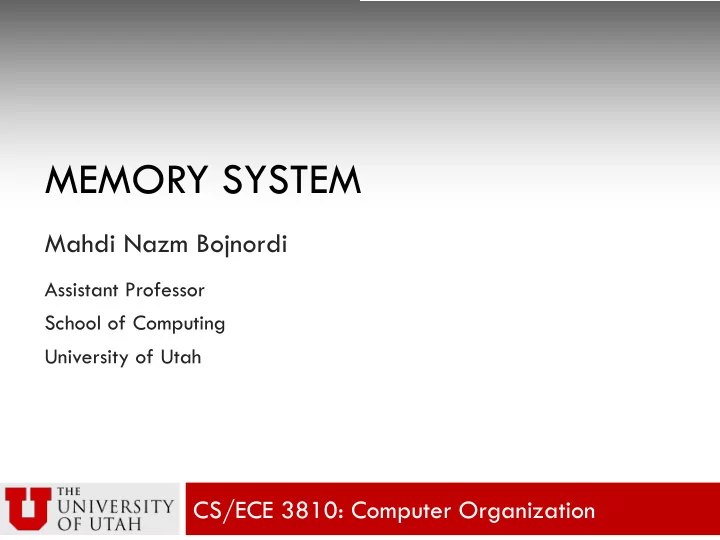

MEMORY SYSTEM Mahdi Nazm Bojnordi Assistant Professor School of Computing University of Utah CS/ECE 3810: Computer Organization
Overview ¨ Notes ¤ Homework 9 is due tonight n Verify your submitted file before midnight ¨ This lecture ¤ Direct-mapped ¤ Set-associative
Recall: Direct-Mapped Lookup tag index byte ¨ Byte offset: to select v the requested byte 0 1 ¨ Tag: to maintain the 2 address ¨ Valid flag (v): … whether content is 1021 meaningful 1022 1023 ¨ Data and tag are = always accessed data hit
Example Problem ¨ Find the size of tag, index, and offset bits for an 8MB, direct-mapped L3 cache with 64B cache blocks. Assume that the processor can address up to 4GB of main memory.
Example Problem ¨ Find the size of tag, index, and offset bits for an 8MB, direct-mapped L3 cache with 64B cache blocks. Assume that the processor can address up to 4GB of main memory. ¨ 4GB = 2 32 B à address bits = 32 ¨ 64B = 2 6 B à byte offset bits = 6 ¨ 8MB/64B = 2 17 à index bits = 17 ¨ tag bits = 32 – 6 – 17 = 9
Set Associative Caches ¨ Improve cache hit rate by allowing a memory location to be placed in more than one cache block ¤ N-way set associative cache ¤ Fully associative ¨ For fixed capacity, higher associativity typically leads to higher hit rates ¤ more places to simultaneously map cache lines ¤ 8-way SA close to FA in practice … for (i=0; i<10000; i++) { a a++; b++; } b Memory
Set Associative Caches ¨ Improve cache hit rate by allowing a memory location to be placed in more than one cache block ¤ N-way set associative cache ¤ Fully associative ¨ For fixed capacity, higher associativity typically leads to higher hit rates ¤ more places to simultaneously map cache lines ¤ 8-way SA close to FA in practice … for (i=0; i<10000; i++) { a a++; b++; } b way 1 way 0 Memory
n-Way Set Associative Lookup tag index byte ¨ Index into cache sets v 0 ¨ Multiple tag comparisons 1 ¨ Multiple data reads … ¨ Special cases 510 ¤ Direct mapped 511 n Single block sets ¤ Fully associative mux = = n Single set cache data hit OR
Example Problem ¨ Find the size of tag, index, and offset bits for an 4MB, 4-way set associative cache with 32B cache blocks. Assume that the processor can address up to 4GB of main memory.
Example Problem ¨ Find the size of tag, index, and offset bits for an 4MB, 4-way set associative cache with 32B cache blocks. Assume that the processor can address up to 4GB of main memory. ¨ 4GB = 2 32 B à address bits = 32 ¨ 32B = 2 5 B à byte offset bits = 5 ¨ 4MB/(4x32B) = 2 15 à index bits = 15 ¨ tag bits = 32 – 5 – 15 = 12
Example ¨ Consider a 32 kilobyte (KB) 4-way set-associative data cache array with 32 byte line sizes ¤ How many sets? ¤ How many index bits, offset bits, tag bits? ¤ How large is the tag array?
Example ¨ Consider a 32 kilobyte (KB) 4-way set-associative data cache array with 32 byte line sizes ¤ cache size = no. sets x no. ways x block size ¤ How many sets? ¤ How many index bits, offset bits, tag bits? ¤ How large is the tag array?
Example ¨ Consider a 32 kilobyte (KB) 4-way set-associative data cache array with 32 byte line sizes ¤ cache size = no. sets x no. ways x block size ¤ How many sets? ¤ no. sets = 32x1024 / (4 x 32) = 256 ¤ How many index bits, offset bits, tag bits? 8 5 19 ¤ ¤ How large is the tag array? ¤ no. sets x no. ways x tag bits = 256 x 4 x 19 = 19Kb
Example ¨ A pipeline’s CPI is 1 if all loads/stores hit in cache ¨ Question: 40% of all instructions are loads/stores; 80% of all loads/stores hit in cache (1-cycle); memory access takes 100 cycles; what is the CPI?
Example ¨ A pipeline’s CPI is 1 if all loads/stores hit in cache ¨ Question: 40% of all instructions are loads/stores; 80% of all loads/stores hit in cache (1-cycle); memory access takes 100 cycles; what is the CPI? ¨ Solution: ¤ Consider 1000 instructions; 400 instructions are load/stores, of which 0.8x400 are hits (1 cycle) and 0.2x400 are misses (101 cycles). ¤ CPI = (1x (600 + 320) + 101 x 80)/1000 = 9
Cache Write Policies ¨ Write vs. read ¤ Data and tag are accessed for both read and write ¤ Only for write, data array needs to be updated ¨ Cache write policies hit miss Write lookup Read lower Write lower level? level? Write no allocate Write allocate Write back Write through
Write back ¨ On a write access, write to cache only ¤ write cache block to memory only when replaced from cache ¤ dramatically decreases bus bandwidth usage ¤ keep a bit (called the dirty bit) per cache block Core Cache Main Memory
Write through ¨ Write to both cache and memory (or next level) ¤ Improved miss penalty ¤ More reliable because of maintaining two copies Core Cache Main Memory
Write (No-)Allocate ¨ Write allocate ¤ allocate a cache line for the new data, and replace old line ¤ just like a read miss ¨ Write no allocate ¤ do not allocate space in the cache for the data ¤ only really makes sense in systems with write buffers ¨ How to handle read miss after write miss?
Recommend
More recommend